MAZDA MODEL MAZDASPEED 3 2009 Owners Manual (in English)
Manufacturer: MAZDA, Model Year: 2009, Model line: MODEL MAZDASPEED 3, Model: MAZDA MODEL MAZDASPEED 3 2009Pages: 412, PDF Size: 6.18 MB
Page 371 of 412
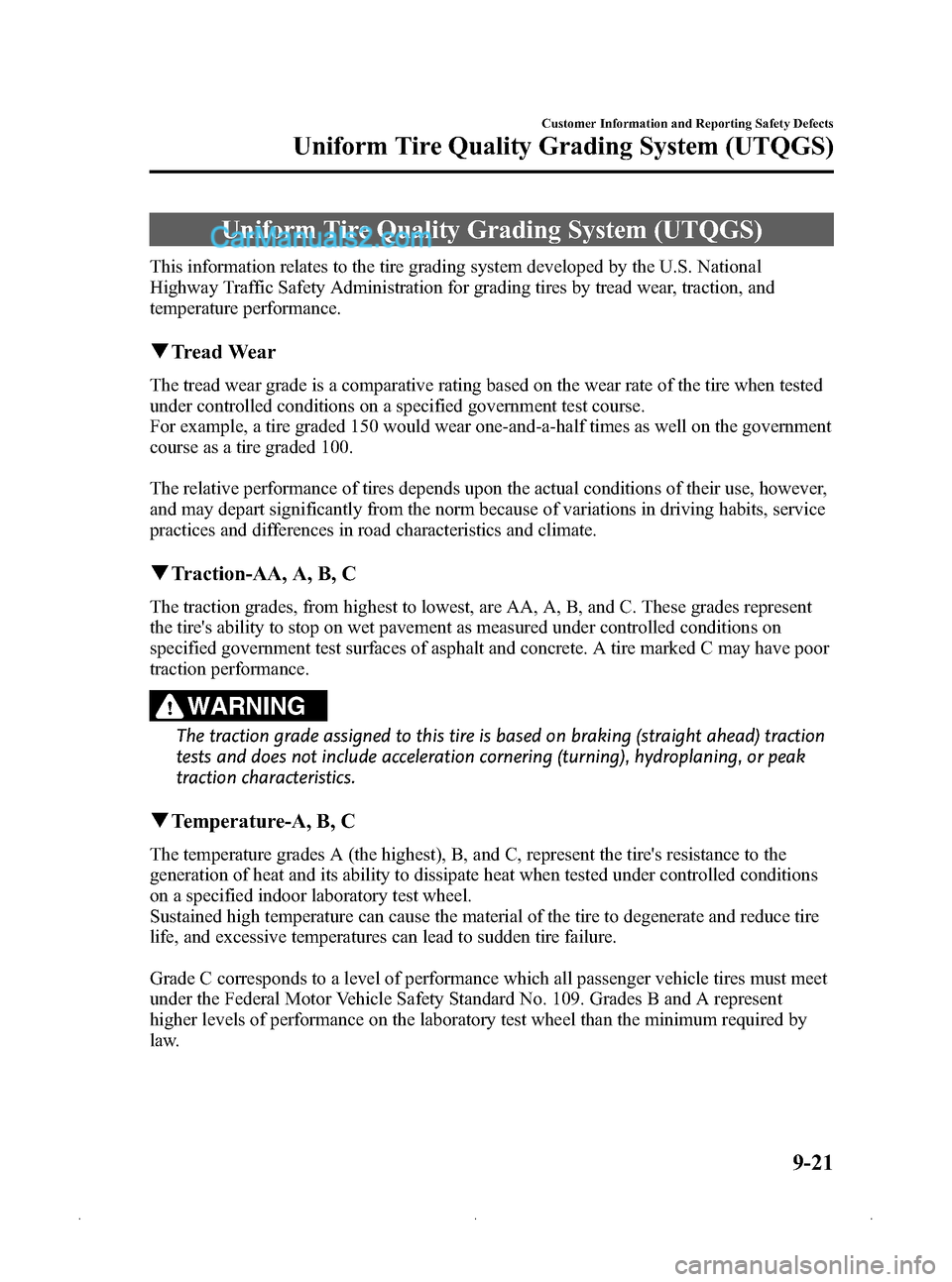
Black plate (371,1)
Uniform Tire Quality Grading System (UTQGS)
This information relates to the tire grading system developed by the U.S. National
Highway Traffic Safety Administration for grading tires by tread wear, traction, and
temperature performance.
qTread Wear
The tread wear grade is a comparative rating based on the wear rate of the tire when tested
under controlled conditions on a specified government test course.
For example, a tire graded 150 would wear one-and-a-half times as well on the government
course as a tire graded 100.
The relative performance of tires depends upon the actual conditions of their use, however,
and may depart significantly from the norm because of variations in driving habits, service
practices and differences in road characteristics and climate.
qTraction-AA, A, B, C
The traction grades, from highest to lowest, are AA, A, B, and C. These grades represent
the tire's ability to stop on wet pavement as measured under controlled conditions on
specified government test surfaces of asphalt and concrete. A tire marked C may have poor
traction performance.
WARNING
The traction grade assigned to this tire is based on braking (straight ahead) traction
tests and does not include acceleration cornering (turning), hydroplaning, or peak
traction characteristics.
qTemperature-A, B, C
The temperature grades A (the highest), B, and C, represent the tire's resistance to the
generation of heat and its ability to dissipate heat when tested under controlled conditions
on a specified indoor laboratory test wheel.
Sustained high temperature can cause the material of the tire to degenerate and reduce tire
life, and excessive temperatures can lead to sudden tire failure.
Grade C corresponds to a level of performance which all passenger vehicle tires must meet
under the Federal Motor Vehicle Safety Standard No. 109. Grades B and A represent
higher levels of performance on the laboratory test wheel than the minimum required by
law.
Customer Information and Reporting Safety Defects
Uniform Tire Quality Grading System (UTQGS)
9-21
Mazda3_8Z87-EA-08F_Edition1 Page371
Monday, May 19 2008 9:59 AM
Form No.8Z87-EA-08F
Page 372 of 412
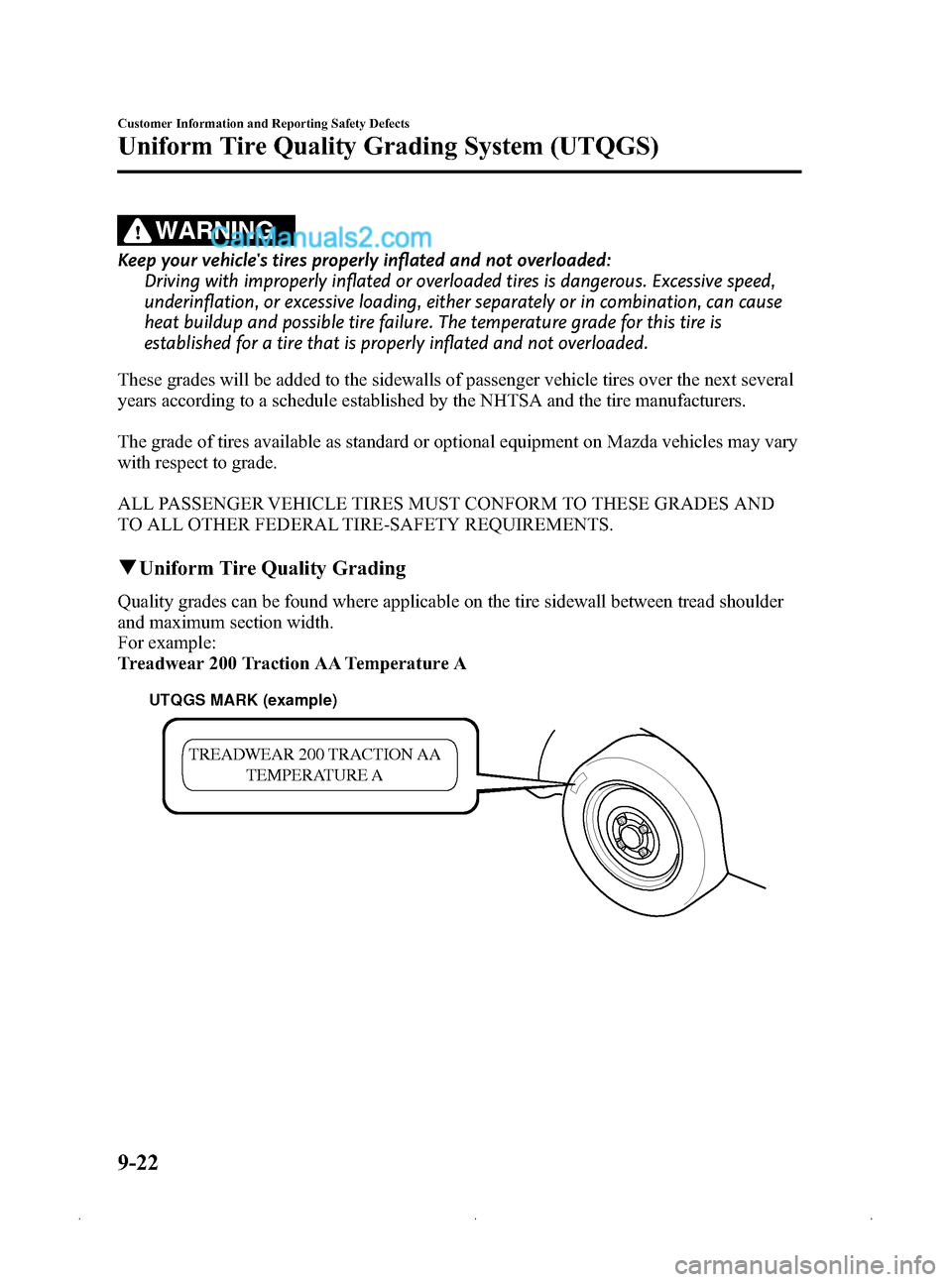
Black plate (372,1)
WARNING
Keep your vehicle's tires properly inflated and not overloaded:Driving with improperly inflated or overloaded tires is dangerous. Excessive speed,
underinflation, or excessive loading, either separately or in combination, can cause
heat buildup and possible tire failure. The temperature grade for this tire is
established for a tire that is properly inflated and not overloaded.
These grades will be added to the sidewalls of passenger vehicle tires over the next several
years according to a schedule established by the NHTSA and the tire manufacturers.
The grade of tires available as standard or optional equipment on Mazda vehicles may vary
with respect to grade.
ALL PASSENGER VEHICLE TIRES MUST CONFORM TO THESE GRADES AND
TO ALL OTHER FEDERAL TIRE-SAFETY REQUIREMENTS.
q Uniform Tire Quality Grading
Quality grades can be found where applicable on the tire sidewall between tread shoulder
and maximum section width.
For example:
Treadwear 200 Traction AA Temperature A
TREADWEAR 200 TRACTION AA
TEMPERATURE A
UTQGS MARK (example)
9-22
Customer Information and Reporting Safety Defects
Uniform Tire Quality Grading System (UTQGS)
Mazda3_8Z87-EA-08F_Edition1 Page372
Monday, May 19 2008 9:59 AM
Form No.8Z87-EA-08F
Page 373 of 412
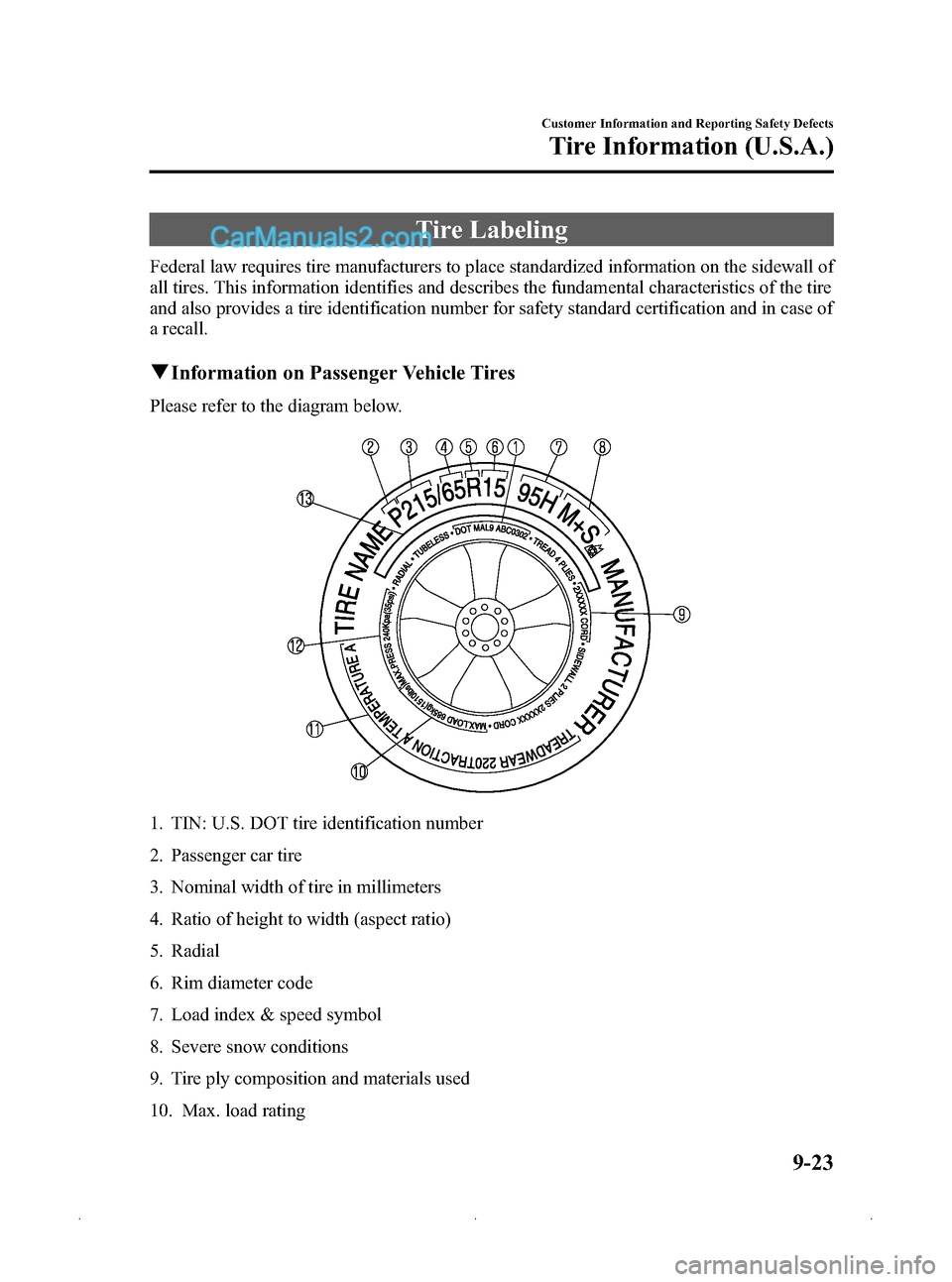
Black plate (373,1)
Tire Labeling
Federal law requires tire manufacturers to place standardized information on the sidewall of
all tires. This information identifies and describes the fundamental characteristics of the tire
and also provides a tire identification number for safety standard certification and in case of
a recall.
qInformation on Passenger Vehicle Tires
Please refer to the diagram below.
1. TIN: U.S. DOT tire identification number
2. Passenger car tire
3. Nominal width of tire in millimeters
4. Ratio of height to width (aspect ratio)
5. Radial
6. Rim diameter code
7. Load index & speed symbol
8. Severe snow conditions
9. Tire ply composition and materials used
10. Max. load rating
Customer Information and Reporting Safety Defects
Tire Information (U.S.A.)
9-23
Mazda3_8Z87-EA-08F_Edition1 Page373
Monday, May 19 2008 9:59 AM
Form No.8Z87-EA-08F
Page 374 of 412
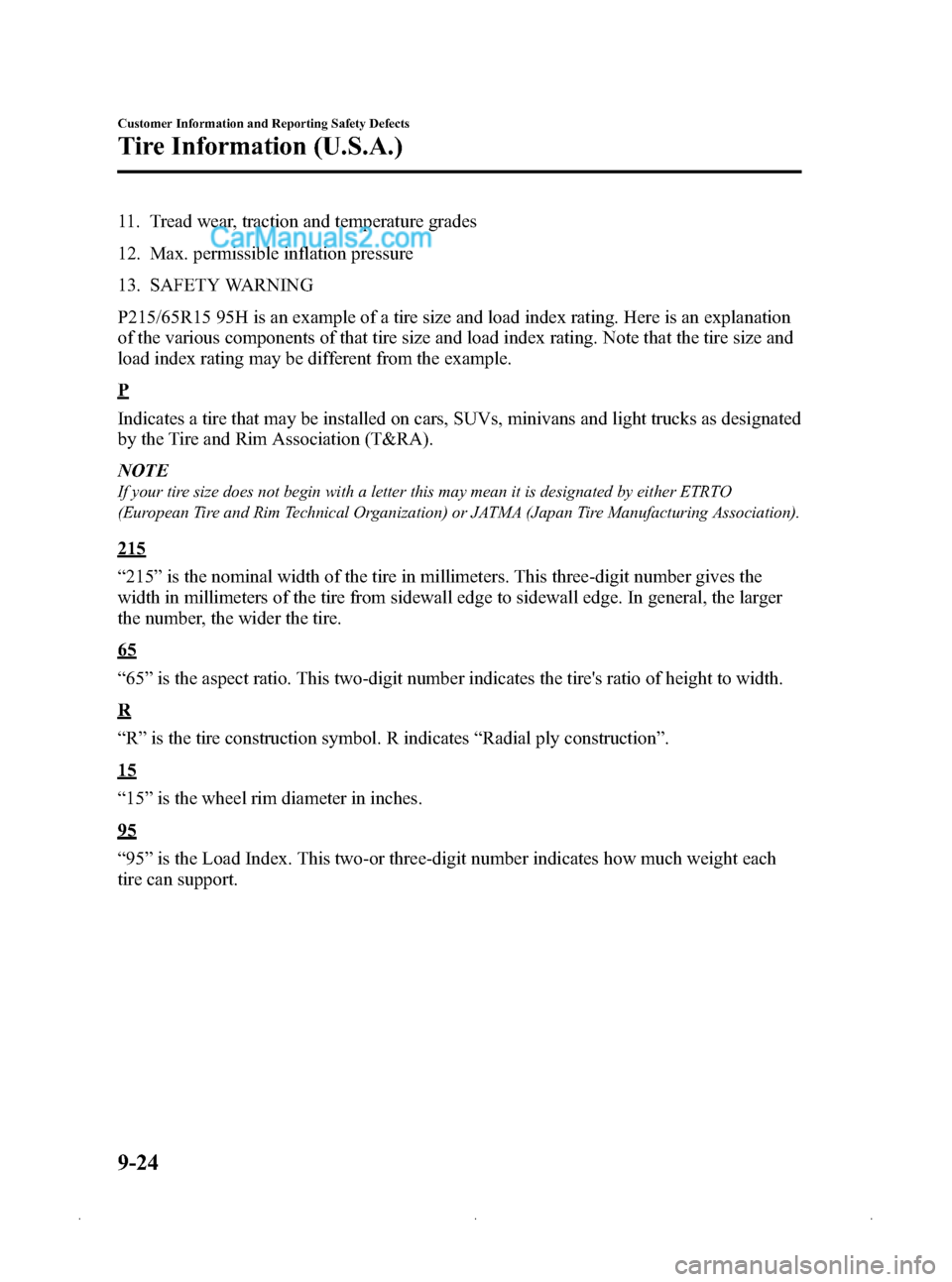
Black plate (374,1)
11. Tread wear, traction and temperature grades
12. Max. permissible inflation pressure
13. SAFETY WARNING
P215/65R15 95H is an example of a tire size and load index rating. Here is an explanation
of the various components of that tire size and load index rating. Note that the tire size and
load index rating may be different from the example.
P
Indicates a tire that may be installed on cars, SUVs, minivans and light trucks as designated
by the Tire and Rim Association (T&RA).
NOTE
If your tire size does not begin with a letter this may mean it is designated by either ETRTO
(European Tire and Rim Technical Organization) or JATMA (Japan Tire Manufacturing Association).
215
“215 ”is the nominal width of the tire in millimeters. This three-digit number gives the
width in millimeters of the tire from sidewall edge to sidewall edge. In general, the larger
the number, the wider the tire.
65
“ 65 ”is the aspect ratio. This two-digit number indicates the tire's ratio of height to width.
R
“R” is the tire construction symbol. R indicates “Radial ply construction ”.
15
“15 ”is the wheel rim diameter in inches.
95
“95 ”is the Load Index. This two-or three-digit number indicates how much weight each
tire can support.
9-24
Customer Information and Reporting Safety Defects
Tire Information (U.S.A.)
Mazda3_8Z87-EA-08F_Edition1 Page374
Monday, May 19 2008 9:59 AM
Form No.8Z87-EA-08F
Page 375 of 412
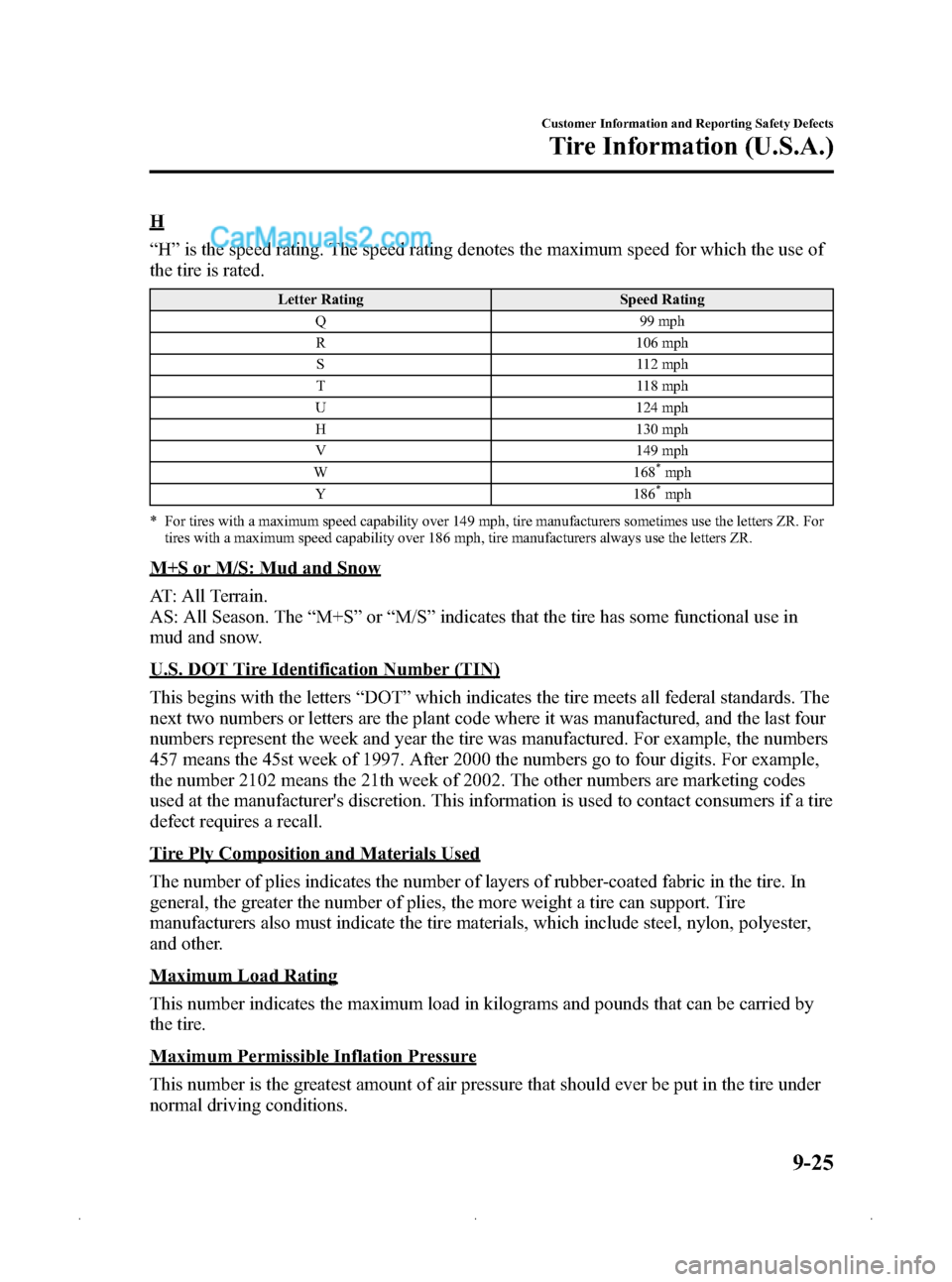
Black plate (375,1)
H
“H ”is the speed rating. The speed rating denotes the maximum speed for which the use of
the tire is rated.
Letter Rating Speed Rating
Q 99 mph
R 106 mph
S 112 mph
T 118 mph
U 124 mph
H 130 mph
V 149 mph
W 168
*mph
Y 186*mph
* For tires with a maximum speed capability over 149 mph, tire manufacturers sometimes use the letters ZR. For tires with a maximum speed capability over 186 mph, tire manufacturers always use the letters ZR.
M+S or M/S: Mud and Snow
AT: All Terrain.
AS: All Season. The “M+S ”or “M/S ”indicates that the tire has some functional use in
mud and snow.
U.S. DOT Tire Identification Number (TIN)
This begins with the letters “DOT ”which indicates the tire meets all federal standards. The
next two numbers or letters are the plant code where it was manufactured, and the last four
numbers represent the week and year the tire was manufactured. For example, the numbers
457 means the 45st week of 1997. After 2000 the numbers go to four digits. For example,
the number 2102 means the 21th week of 2002. The other numbers are marketing codes
used at the manufacturer's discretion. This information is used to contact consumers if a tire
defect requires a recall.
Tire Ply Composition and Materials Used
The number of plies indicates the number of layers of rubber-coated fabric in the tire. In
general, the greater the number of plies, the more weight a tire can support. Tire
manufacturers also must indicate the tire materials, which include steel, nylon, polyester,
and other.
Maximum Load Rating
This number indicates the maximum load in kilograms and pounds that can be carried by
the tire.
Maximum Permissible Inflation Pressure
This number is the greatest amount of air pressure that should ever be put in the tire under
normal driving conditions.
Customer Information and Reporting Safety Defects
Tire Information (U.S.A.)
9-25
Mazda3_8Z87-EA-08F_Edition1 Page375
Monday, May 19 2008 9:59 AM
Form No.8Z87-EA-08F
Page 376 of 412
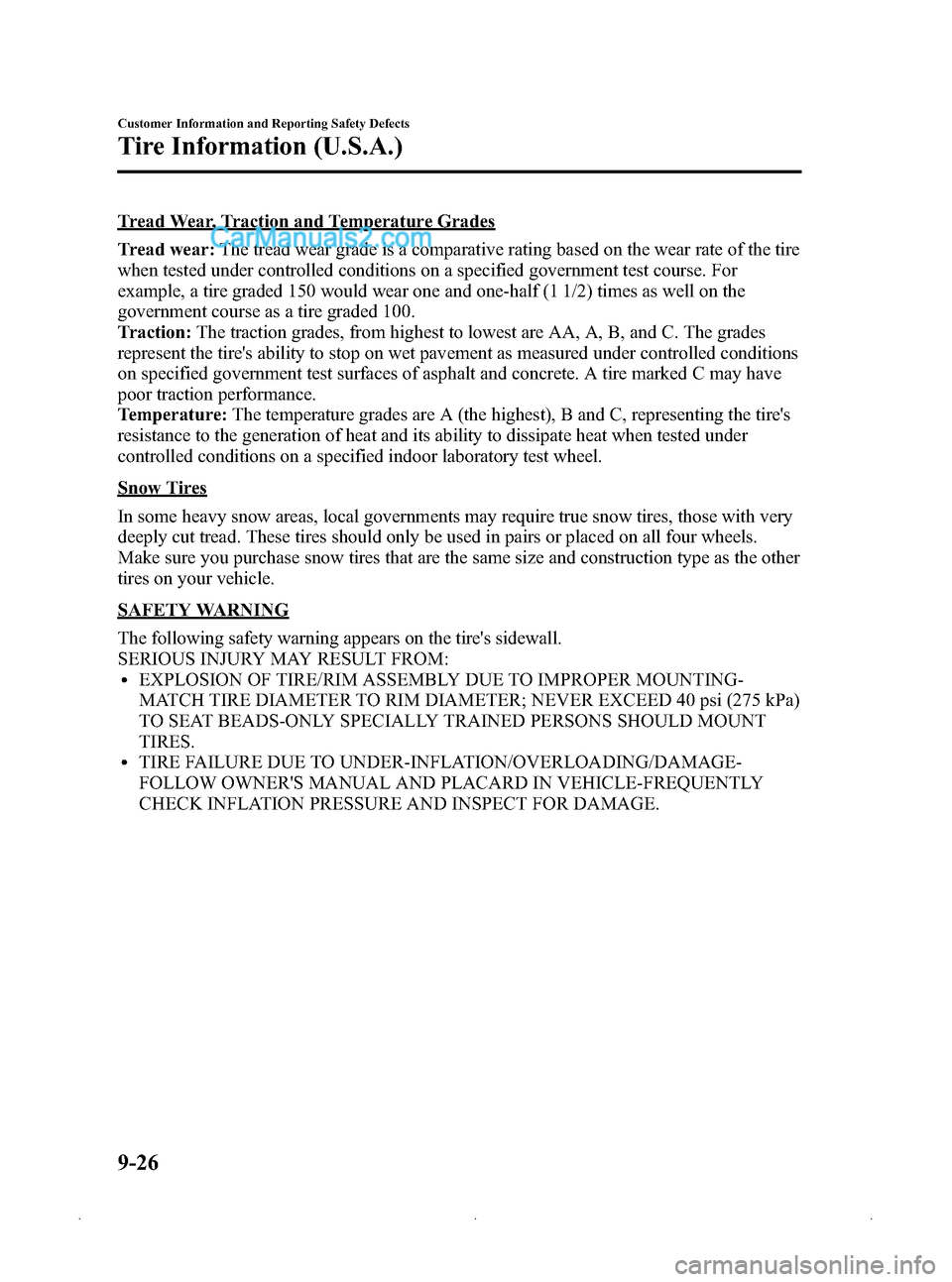
Black plate (376,1)
Tread Wear, Traction and Temperature Grades
Tread wear:The tread wear grade is a comparative rating based on the wear rate of the tire
when tested under controlled conditions on a specified government test course. For
example, a tire graded 150 would wear one and one-half (1 1/2) times as well on the
government course as a tire graded 100.
Traction: The traction grades, from highest to lowest are AA, A, B, and C. The grades
represent the tire's ability to stop on wet pavement as measured under controlled conditions
on specified government test surfaces of asphalt and concrete. A tire marked C may have
poor traction performance.
Temperature: The temperature grades are A (the highest), B and C, representing the tire's
resistance to the generation of heat and its ability to dissipate heat when tested under
controlled conditions on a specified indoor laboratory test wheel.
Snow Tires
In some heavy snow areas, local governments may require true snow tires, those with very
deeply cut tread. These tires should only be used in pairs or placed on all four wheels.
Make sure you purchase snow tires that are the same size and construction type as the other
tires on your vehicle.
SAFETY WARNING
The following safety warning appears on the tire's sidewall.
SERIOUS INJURY MAY RESULT FROM:
lEXPLOSION OF TIRE/RIM ASSEMBLY DUE TO IMPROPER MOUNTING-
MATCH TIRE DIAMETER TO RIM DIAMETER; NEVER EXCEED 40 psi (275 kPa)
TO SEAT BEADS-ONLY SPECIALLY TRAINED PERSONS SHOULD MOUNT
TIRES.
lTIRE FAILURE DUE TO UNDER-INFLATION/OVERLOADING/DAMAGE-
FOLLOW OWNER'S MANUAL AND PLACARD IN VEHICLE-FREQUENTLY
CHECK INFLATION PRESSURE AND INSPECT FOR DAMAGE.
9-26
Customer Information and Reporting Safety Defects
Tire Information (U.S.A.)
Mazda3_8Z87-EA-08F_Edition1 Page376
Monday, May 19 2008 9:59 AM
Form No.8Z87-EA-08F
Page 377 of 412
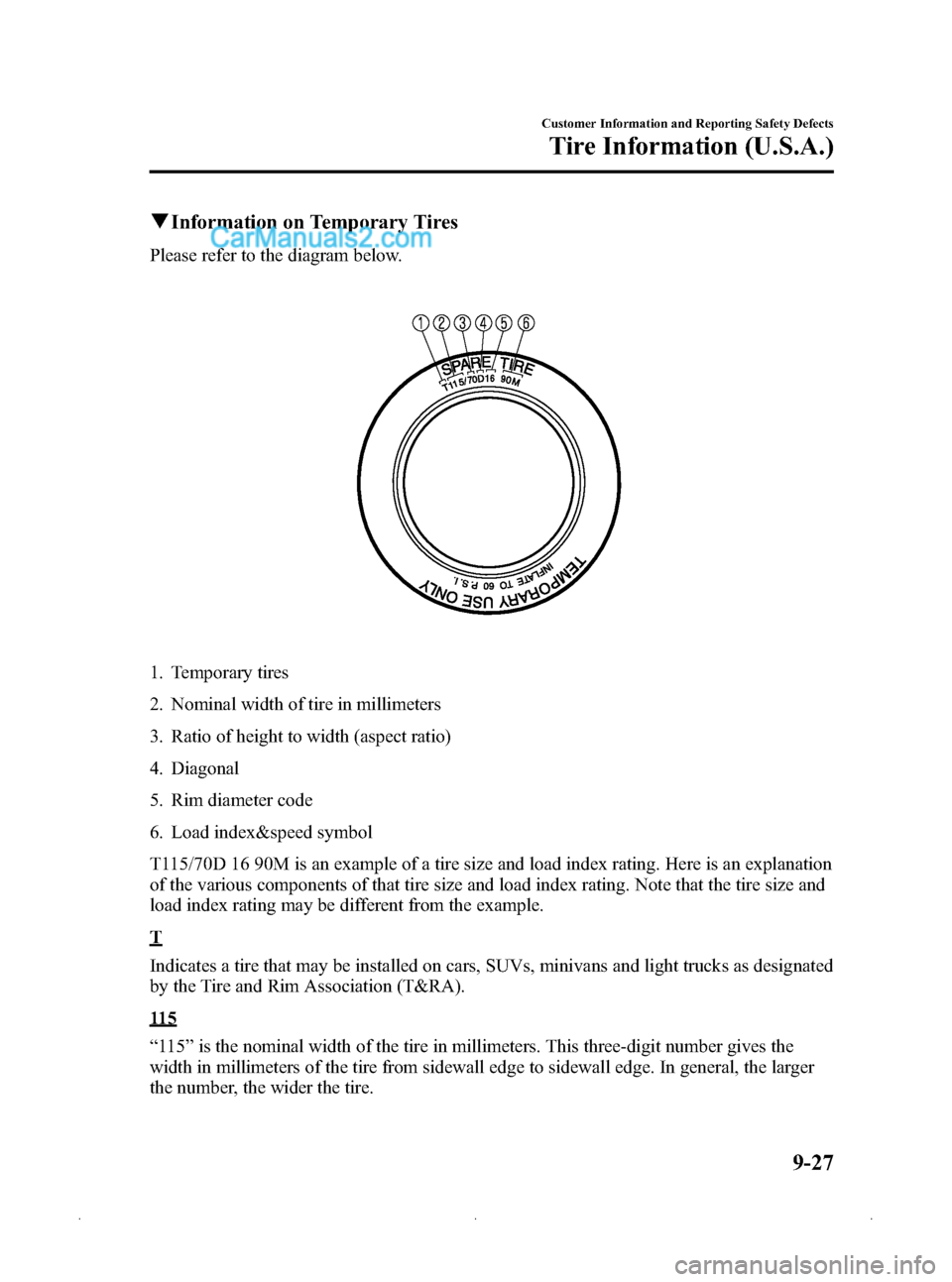
Black plate (377,1)
qInformation on Temporary Tires
Please refer to the diagram below.
1. Temporary tires
2. Nominal width of tire in millimeters
3. Ratio of height to width (aspect ratio)
4. Diagonal
5. Rim diameter code
6. Load index&speed symbol
T115/70D 16 90M is an example of a tire size and load index rating. Here is an explanation
of the various components of that tire size and load index rating. Note that the tire size and
load index rating may be different from the example.
T
Indicates a tire that may be installed on cars, SUVs, minivans and light trucks as designated
by the Tire and Rim Association (T&RA).
115
“115 ”is the nominal width of the tire in millimeters. This three-digit number gives the
width in millimeters of the tire from sidewall edge to sidewall edge. In general, the larger
the number, the wider the tire.
Customer Information and Reporting Safety Defects
Tire Information (U.S.A.)
9-27
Mazda3_8Z87-EA-08F_Edition1 Page377
Monday, May 19 2008 9:59 AM
Form No.8Z87-EA-08F
Page 378 of 412
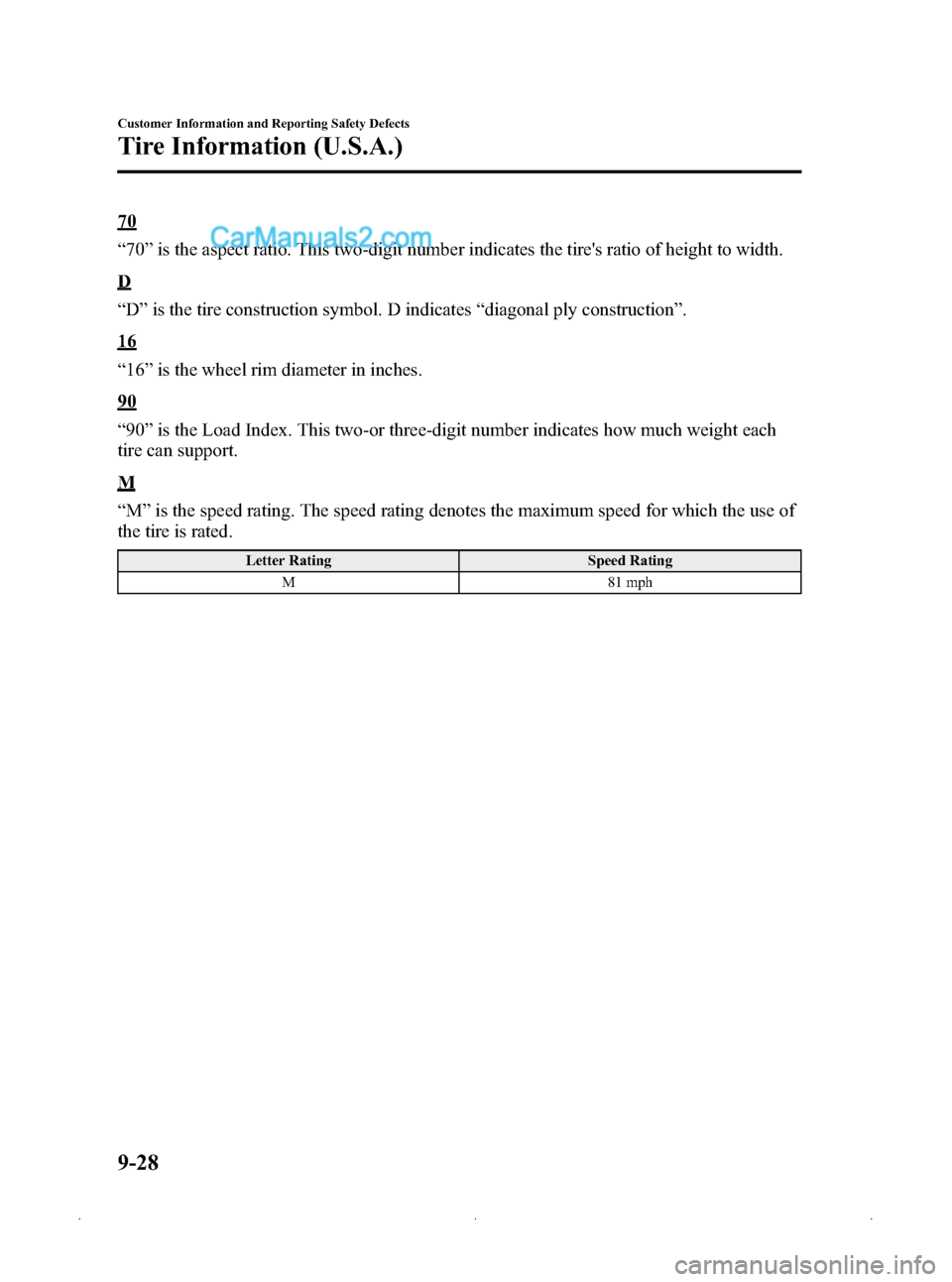
Black plate (378,1)
70
“70 ”is the aspect ratio. This two-digit number indicates the tire's ratio of height to width.
D
“D ”is the tire construction symbol. D indicates “diagonal ply construction ”.
16
“16 ”is the wheel rim diameter in inches.
90
“90 ”is the Load Index. This two-or three-digit number indicates how much weight each
tire can support.
M
“ M ”is the speed rating. The speed rating denotes the maximum speed for which the use of
the tire is rated.
Letter Rating Speed Rating
M 81 mph
9-28
Customer Information and Reporting Safety Defects
Tire Information (U.S.A.)
Mazda3_8Z87-EA-08F_Edition1 Page378
Monday, May 19 2008 9:59 AM
Form No.8Z87-EA-08F
Page 379 of 412
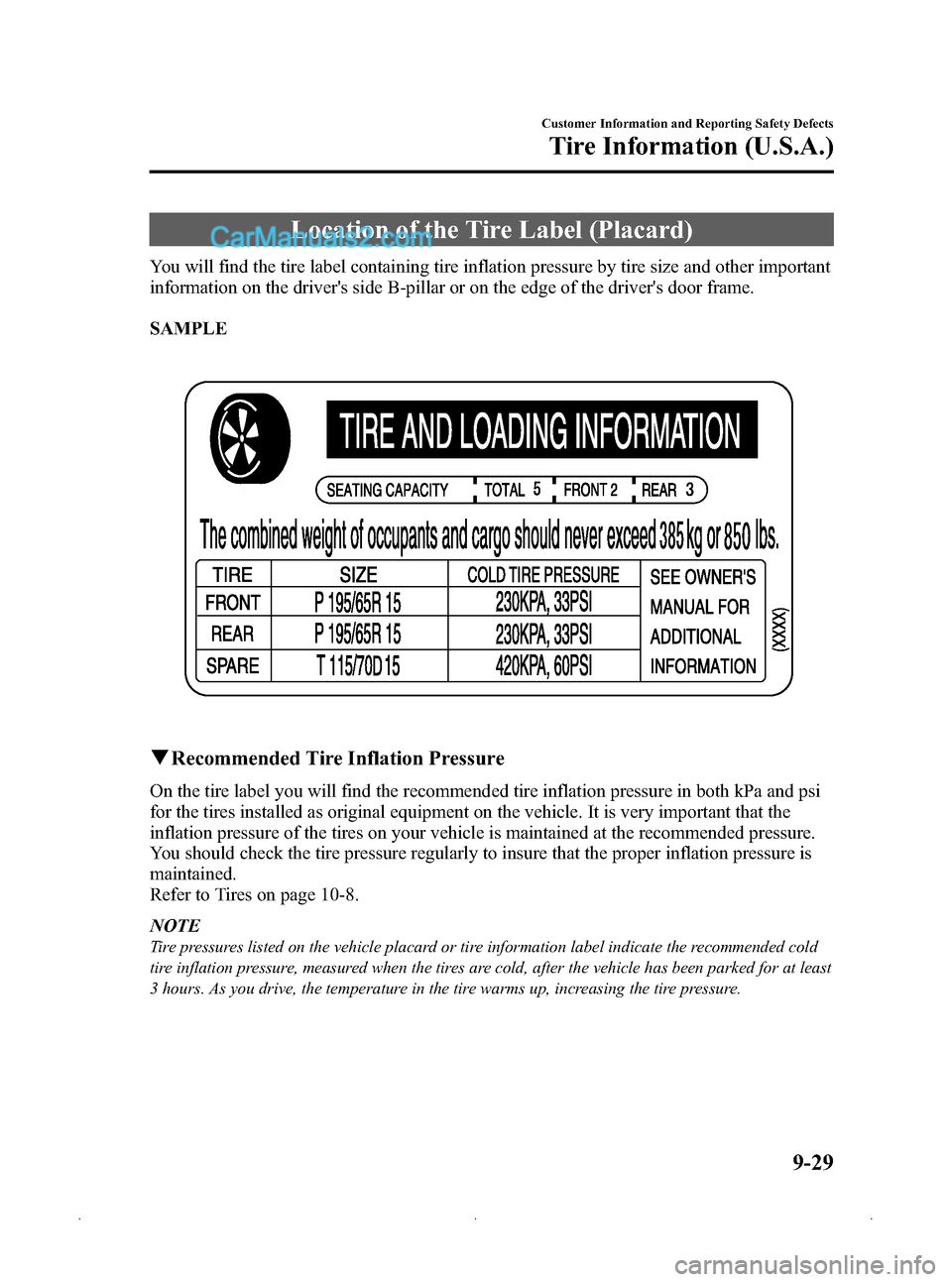
Black plate (379,1)
Location of the Tire Label (Placard)
You will find the tire label containing tire inflation pressure by tire size and other important
information on the driver's side B-pillar or on the edge of the driver's door frame.
SAMPLE
qRecommended Tire Inflation Pressure
On the tire label you will find the recommended tire inflation pressure in both kPa and psi
for the tires installed as original equipment on the vehicle. It is very important that the
inflation pressure of the tires on your vehicle is maintained at the recommended pressure.
You should check the tire pressure regularly to insure that the proper inflation pressure is
maintained.
Refer to Tires on page 10-8.
NOTE
Tire pressures listed on the vehicle placard or tire information label indicate the recommended cold
tire inflation pressure, measured when the tires are cold, after the vehicle has been parked for at least
3 hours. As you drive, the temperature in the tire warms up, increasing the tire pressure.
Customer Information and Reporting Safety Defects
Tire Information (U.S.A.)
9-29
Mazda3_8Z87-EA-08F_Edition1 Page379
Monday, May 19 2008 9:59 AM
Form No.8Z87-EA-08F
Page 380 of 412
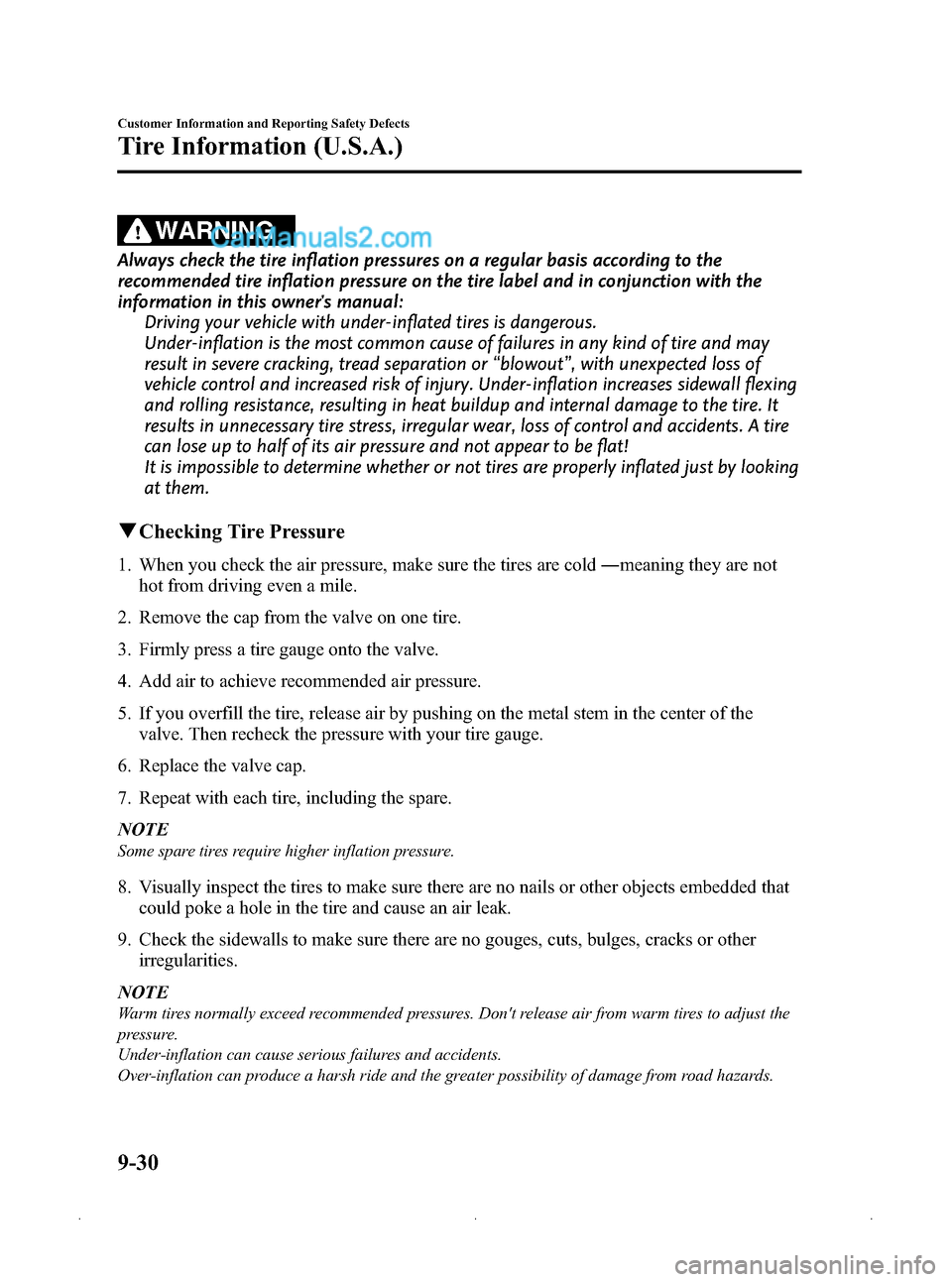
Black plate (380,1)
WARNING
Always check the tire inflation pressures on a regular basis according to the
recommended tire inflation pressure on the tire label and in conjunction with the
information in this owner's manual:Driving your vehicle with under-inflated tires is dangerous.
Under-inflation is the most common cause of failures in any kind of tire and may
result in severe cracking, tread separation or “blowout ”, with unexpected loss of
vehicle control and increased risk of injury. Under-inflation increases sidewall flexing
and rolling resistance, resulting in heat buildup and internal damage to the tire. It
results in unnecessary tire stress, irregular wear, loss of control and accidents. A tire
can lose up to half of its air pressure and not appear to be flat!
It is impossible to determine whether or not tires are properly inflated just by looking
at them.
q Checking Tire Pressure
1. When you check the air pressure, make sure the tires are cold ―meaning they are not
hot from driving even a mile.
2. Remove the cap from the valve on one tire.
3. Firmly press a tire gauge onto the valve.
4. Add air to achieve recommended air pressure.
5. If you overfill the tire, release air by pushing on the metal stem in the center of the valve. Then recheck the pressure with your tire gauge.
6. Replace the valve cap.
7. Repeat with each tire, including the spare.
NOTE
Some spare tires require higher inflation pressure.
8. Visually inspect the tires to make sure there are no nails or other objects embedded that could poke a hole in the tire and cause an air leak.
9. Check the sidewalls to make sure there are no gouges, cuts, bulges, cracks or other irregularities.
NOTE
Warm tires normally exceed recommended pressures. Don't release air from warm tires to adjust the
pressure.
Under-inflation can cause serious failures and accidents.
Over-inflation can produce a harsh ride and the greater possibility of damage from road hazards.
9-30
Customer Information and Reporting Safety Defects
Tire Information (U.S.A.)
Mazda3_8Z87-EA-08F_Edition1 Page380
Monday, May 19 2008 9:59 AM
Form No.8Z87-EA-08F